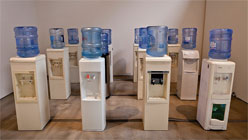The first vividly bleak picture of the contemporary office environment was painted by Mike Judge, whose 1999 film Office Space made the prosaic struggle to control a lowly stapler a metaphor for oppressed white-color workers everywhere. The 2001 Ricky Gervais show The Office, followed in 2005 by the Greg Daniels version for U.S. audiences, codified the dull despair of those who push paper in order to sell it. Naturally, both were comedies, otherwise the exercises would have been unbearable.
The Office, on display now through June 2, 2012, at the San Jose Institute of Contemporary Art, owes as much to these pop-culture phenomena as to the comparatively stuffy traditions of visual art. Indeed, the pieces in the show that try to play the art game first — rather than mining all they can from their subject — are generally less successful than their counterparts.


Packard Jennings, Business Reply Pamphlet, Panels 1 and 16
Take the work of Packard Jennings, whose cartoony illustrations for Business Reply Pamphlet, 2006, were initially designed for the business-reply envelopes that accompany junk mail. Jennings conceived his 16-part piece as an instruction manual for office workers whose job it is to open those returned business-reply envelopes, the charming conceit being that Jennings’s handy how-to manual would enable them to overthrow their office hierarchy and replace it with a tribal culture in which the work space is used for homesteading, hunting and growing crops. Coincidentally, Jennings’s aesthetic lends itself to the content of his piece, but he was smart to recognize this bizarre opportunity.




